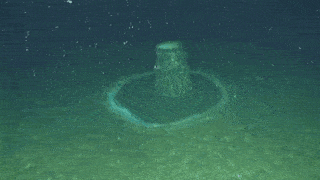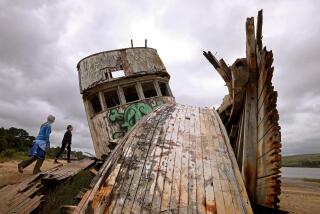Editorial: We need faster action on removing the DDT graveyard off the L.A. coast

- Share via
On a clear day, looking south from Rancho Palos Verdes’ Point Vicente Lighthouse across the San Pedro Channel to Catalina Island offers a stunning postcard-worthy vista of coastline, sparkling blue water and the busy comings-and-goings from the ports of Los Angeles and Long Beach.
What you can’t see is what lies below the water: As many as 500,000 corroding barrels of DDT, an extremely effective insecticide the U.S. government banned in 1972 because it caused long-term damage to the environment and wildlife — and because it was a probable human carcinogen.
How those barrels wound up on the bottom of the San Pedro Channel was detailed last October by The Times’ Rosanna Xia. Recounting a practice that began in the years after World War II, she reported how contractors working for Montrose Chemical Corp. of Torrance loaded reinforced barrels of the dangerous chemical onto boats, chugged a few miles out into the channel and pushed them overboard. Often they pounded holes in the sides of the barrels to ensure they’d sink 3,000 feet to the bottom of the San Pedro Basin.
Xia based her reporting on work going back decades by several researchers, most recently a project by David Valentine, a professor at UC Santa Barbara’s Marine Science Institute, who used a borrowed deep-sea robot to capture images of the rusting and leaking barrels.
The presence of the barrels has long been known to state and federal regulators, who sidelined the matter in favor what seemed to be a more pressing problem — Montrose’s discharge of DDT and PCBs, another banned substance, through offshore sewer pipes. That discharge zone, 17 square miles in size and about 200 feet down just off Palos Verdes, is a Superfund cleanup site.
Officials initially decided to bury the most contaminated part of the seafloor with a layer of sand, hoping to seal it in place. That pilot project initially seemed to work, but later tests revealed more DDT. The EPA is now considering other options.
If you look out from Point Vicente for the next few weeks, you may see the research vessel Sally Ride mixed among the ships and boats plying the channel. Those aboard include 31 scientists and crew members who are mapping 50,000 acres of seafloor to try to catalog the scope of the DDT barrel graveyard, a critical early step in trying to figure out the best way to deal with the barrels and chemical seepage.
It’s frustrating that the federal government has moved so slowly to address such a significant environmental hazard. Recent studies have linked the incidence of cancer among sea lions to DDT, most likely ingested and concentrated as the poison moved its way up the food chain.
Although the seabird populations that had declined because of DDT exposure have rebounded in recent years, the lingering presence in wildlife of the slow-to-decompose chemical remains a risk to top predators, including dolphins, which accumulate the chemical in their fat after eating infected prey.
Granted, there are no easy resolutions here. Simply removing the contaminated seafloor soil would be astronomically expensive, and then the government would have to do something with it. Ocean currents and naturally shifting sands compound the challenge, as does the depth at which the pollutants have rested.
But knowing that it will be difficult to remedy the contamination doesn’t justify lack of focused, deliberate action.
More to Read
A cure for the common opinion
Get thought-provoking perspectives with our weekly newsletter.
You may occasionally receive promotional content from the Los Angeles Times.










